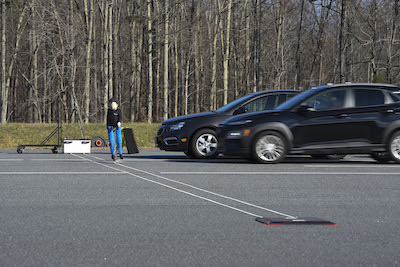DISCOVER YOUR LOCAL BICYCLING COMMUNITY
Find local advocacy groups, bike shops, instructors, clubs, classes and more!
IIHS tests show U.S. vehicles can give pedestrians a brake – but U.S. still far from leading on automated safety systems
In laying out a vision for a Bike New Deal, I said that one principle of a bike-forward future is: “The U.S. is a leader again on vehicle and road safety standards.” Today, new safety ratings from the Insurance Institute for Highway Safety (IIHS) highlight some fantastic progress, but also show just how far behind the United States has fallen on road and vehicle safety.
This morning, IIHS announced nine of 11 small SUVs it evaluated earned an advanced or superior rating for pedestrian crash prevention. This is a great announcement as it means consumers in the United States can purchase vehicles equipped with automated emergency braking (AEB) systems that can reduce pedestrian deaths and serious injuries. For example, IIHS research suggests the Subaru EyeSight system with pedestrian detection cut the rate of pedestrian-related insurance claims by 35 percent. Vehicles tested by IIHS were scored by their speed reduction based on AEB, with vehicles like the Subaru Forester and Toyota RAV4 completely avoiding hitting pedestrian dummies when their AEB system was triggered while approaching at speeds of up to 25 mph.
 The IIHS announcement tells us that vehicle manufacturers currently equip their vehicles with pedestrian crash prevention systems and that at least some of them work very well. However, it also highlights just how far behind the United States is compared to other nations in making pedestrian and bicycle safety a priority through vehicle safety standards. The IIHS tests for pedestrian crash prevention are new as of this year. While IIHS notes that many of these systems can detect and react to bicyclists, IIHS does not currently have a test for whether these systems are effective at doing so. It would be great for IIHS to have a bicyclist safety test as well, but we should recognize that IIHS is doing its best to fill a vital role in testing vehicle technology without much help from the federal government.
The IIHS announcement tells us that vehicle manufacturers currently equip their vehicles with pedestrian crash prevention systems and that at least some of them work very well. However, it also highlights just how far behind the United States is compared to other nations in making pedestrian and bicycle safety a priority through vehicle safety standards. The IIHS tests for pedestrian crash prevention are new as of this year. While IIHS notes that many of these systems can detect and react to bicyclists, IIHS does not currently have a test for whether these systems are effective at doing so. It would be great for IIHS to have a bicyclist safety test as well, but we should recognize that IIHS is doing its best to fill a vital role in testing vehicle technology without much help from the federal government.
In the United States, the National Highway Traffic Safety Administration (NHTSA) should also be administering these types of tests and could do so under its New Car Assessment Program (NCAP) framework that provide 5-star ratings to new vehicles. NCAP ratings are supposed to provide consumers with information so that they can choose safer cars, but currently does not even provide information about crash prevention systems like AEB. In 2015, Congress passed a law requiring such information to be included but it has yet to be implemented.
Compare this to Europe, where 12 nations participate in Euro NCAP, which is equivalent to NHTSA’s 5-star program. The Euro NCAP tests AEB systems for their effectiveness for detecting and responding to both bicyclists and pedestrians. Earlier this month, 40 countries–but not the United States–agreed to make AEB standard “as soon as next year.” This means that consumers and safety advocates in those 12 European countries may have standard AEB systems that are tested for their ability to reduce crashes with bicyclists and pedestrians by 2020.
In the United States, there is a voluntary agreement by 20 manufacturers that sell more than 90 percent of vehicles to have AEB as standard equipment by 2022. There is no published timeline in that voluntary agreement or from NHTSA for when those systems might be tested for their ability to reduce crashes with bicyclists and pedestrians. NHTSA’s website currently says, “NHTSA recognizes [Pedestrian] AEB as a promising technology that may be added to the 5-Star Safety Ratings list of recommended technologies in the future” and makes no mention of bicyclist AEB.
Consumers and manufacturers are not being well served by low vehicle-safety standards provided by NHTSA’s NCAP 5-star ratings. In recent years, roughly 90% of vehicles rated have been awarded 4 or 5 stars, while new technologies that might save lives have gone untested and unacknowledged. This is a sign that we are not striving for zero traffic deaths by providing consumers the information necessary to distinguish between safer and less safe vehicles. Rather than building a case through evidence that automated safety systems like AEB save lives through testing, we are being asked to assume the best of automated vehicles without information on some of the crucial underlying technology that has made them possible.
I commend IIHS for doing the important work of testing vehicle safety systems like AEB and auto manufacturers for building systems that score so well in avoiding or mitigating crashes with pedestrians. But the fact that these systems perform so well and are already available on 2/3rds of vehicles makes me wonder why we will be waiting until 2022 or later to have what similarly industrialized countries in Europe have today – testing of AEB systems for bicyclist and pedestrian safety.
The United States should be a leader in vehicle safety, but this report only highlights how far behind we have fallen.